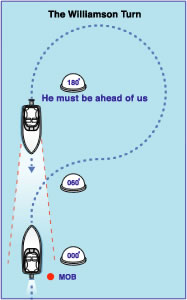
Recovery of Man Overboard
Techniques for man overboard recovery for powerboats and RIBs.
If someone goes overboard:
- Alert the crew by shouting 'Man overboard'.
- Instruct one person to point at the MOB at all times.
- At slow speed turn the wheel towards the MOB. This moves the prop away from the MOB.
- Effect a slow controlled turn back towards the MOB.
- Make a DSC distress alert and Mayday call.
Recovery

Make sure you know which recovery method best suits your boat and crew.
Remember - muscles lose their strength very quickly in cold water so do not expect much help from the MOB. Practise just in case you have to do it for real one day.
Method 1: Into the Wind
- Give plenty of room and approach from downwind.
- Reduce power, and then move slowly towards the MOB.
- Use neutral to control your speed.
- Keep the MOB on the windward bow.
- When close enough, remove all power and grab hold of the MOB.
- Switch off the engine.*
- Assist the MOB to an area of the boat where they can be recovered.
*As skipper you need to balance switching off the engine for the safety of the MOB against the experience of the helm and the sea conditions you are facing.
Advantages
- Suits smaller craft with low freeboards.
- Allows waves to be taken head-on.
- Good when rough as MOB is unlikely to go under the boat.
Disadvantages
- Need to be prompt at collection time.
- Can lose sight of MOB under the bow
- Can be difficult if alone in boat.
Method2: beam on approach

- Drive upwind of the MOB.
- Stop and position upwind of MOB.
- Slowly adjust position to drift down onto the MOB
- When alongside switch off engine.*
*As skipper you need to balance switching off the engine for the safety of the MOB against the experience of the helm and the sea conditions you are facing.
Advantages
- Suits high-bowed vessels where sight of MOB is easily lost while approaching them into the wind.
- Greater collection area – whole side of vessel.
- Provides some shelter to MOB. Allows boat to be easily brought alongside MOB by cockpit area, where freeboard is lowest.
Disadvantages
- Can be uncomfortable beam onto sea.
- Small craft can be blown over the MOB.
The Williamson turn

If it is night or poor light you may need to use the Williamson turn to return to the MOB.
This requires a compass orientated turn to return back to the MOB. First alter your heading either way by 60°. Then reverse the turn onto the reciprocal of your original heading. The MOB should be in front of you as you are travelling the reciprocal of your original heading.
Avoiding a MOB
- At slow speed, sharp throttle movements can catch people unawares. Brief the crew before speeding up and ensure they hold on.
-
Don't let the crew leap off the boat onto the pontoon; brief them to secure the boat first and then step onto the pontoon.
-
At higher speed, ensure the crew is seated and holding on. Beware of sudden wheel movements.
-
Supervise young children all the time.
-
Cover MOB in your safety briefing.
Contact UsArticle Published: February 01, 2011 15:34